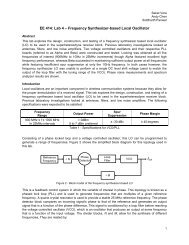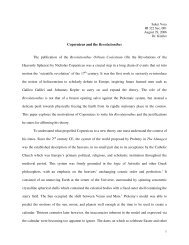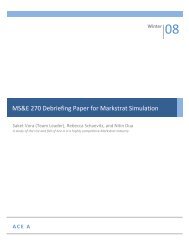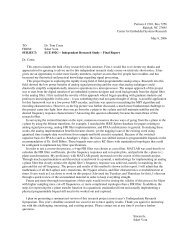Advanced Rowing Instruments – Business Plan & Final ... - Saket Vora
Advanced Rowing Instruments – Business Plan & Final ... - Saket Vora
Advanced Rowing Instruments – Business Plan & Final ... - Saket Vora
Create successful ePaper yourself
Turn your PDF publications into a flip-book with our unique Google optimized e-Paper software.
an 8-bit or higher analog-to-digital converter. Microcontrollers by their nature have digital I/O<br />
pins. These are the only two features that the Mercury model requires.<br />
Feature Mercury Titan<br />
Digital I/O • •<br />
A/D • •<br />
MAC •<br />
SPI •<br />
USART •<br />
Table 4.1: Required processor features.<br />
Because of its increased feature set, the Titan model has a more stringent set of requirements.<br />
Most notably are its off-chip peripheral communication interfaces. This microprocessor must have<br />
a number of standards built in for ease and efficiency of use. Both Serial Peripheral Interface<br />
and Universal Synchronous Asynchronous Reciever Transmitter (USART) must be implemented<br />
for Secure Digital and Bluetooth, respectively. In addition for the more advanced analysis, such<br />
as real-time velocity calculation, a Multiply Accumulate Unit must be included in the processor.<br />
This will allow for the integration and filtering processes to be completed.<br />
4.8.3 Processors Considered<br />
A number of processors were considered for the ARI devices. These included product offerings<br />
from TI and Microchip. Ultimately, Microchip was selected. Datasheet samples for considered<br />
processors can be found in the appendices.<br />
Texas <strong>Instruments</strong> Two processor lines from Texas <strong>Instruments</strong> were considered. The C54xx<br />
and C55xx processor types were both examined for possible use. A development kit for the C54xx<br />
had been previously ordered. Unfortunately, the C54xx did not have an A/D module built it.<br />
Because of power concerns, this model was discarded. In addition a large amount of supporting<br />
circuitry was necessary and as such these processors were overlooked. In future development, the<br />
C55 should be closely examined, however, because it has native SD support.<br />
Microchip Microchip was selected for the Mercury model because its development kit was relatively<br />
inexpensive and readily available. The PIC18F4520 was selected as the primary processor<br />
for the Mercury. It had the necessary features for both Mercury and Titan with the exception of a<br />
MAC . In addition, Microchip offers DSP products that are mostly compatible with code written<br />
for the PIC18. Therefore, when the Titan comes under development, existing Mercury code can be<br />
easily ported to the new processor for new functionality on a shorter software development cycle.<br />
Products offered by other compaines were not as easy to integrate in a short time, nor were they<br />
able to meet the develoment cost profile necessary. Most other processor offerings also required<br />
external crystal oscillation, increasing layout complexity. Becuase of the short development cycle,<br />
this was undesirable.<br />
46









